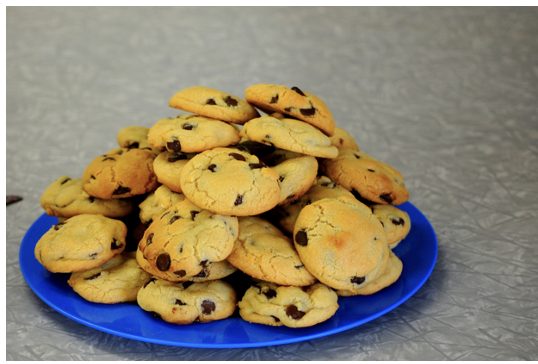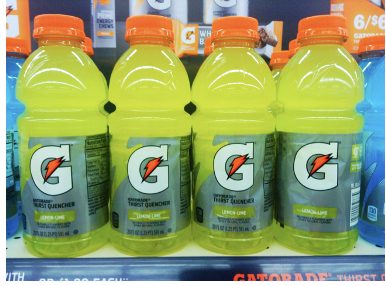Picture this – you walk into a new bakery. The smells hit you from every direction. You see the different kinds of frosting oozing out of the glass case showing off all the new goodies. Where could you possibly be you might wonder… You’re at Crumbl Cookies! Crumbl is a new-ish national cookie franchise that sells its unique, freshly baked, rotating flavored cookies out of most big cities around the country. Emphasis on the *unique* part.
But, is it really unique? Crumbl discovered two cookie companies were trying to copy their packaging, logos, and rotating weekly ensemble of cookie flavors. As a result, Crumbl filed two lawsuits against two of its competitors, Dirty Dough and Crave Cookies in May of 2022, alleging trademark and trade dress infringement.

Courtesy of Brian Richardson, Creative Commons.
Trademarks, Trade Dress, and Infringement – Oh My!
Before we get into the contents of this case (for brevity, we’ll just be focused on the Dirty Dough case), let’s first discuss what trademarks, trade dress, and trademark infringement actually are! Trademarks are a type of intellectual property. A valid trademark is anything that is used in commerce on goods or services if it identifies and distinguishes the source. Think about the Coca-Cola logo, or the Amazon logo on your iPhone or computer! Those are both examples of valid trademarks. When you see them, you automatically associate that product with that specific company. Valid trademarks can even be marks that don’t have any words/writing on them, like the Nike logo. You automatically know that the shoe is associated with the Nike brand just by seeing the “Swoosh!”

Courtesy of Mike Mozart, Creative Commons.
A specific type of trademark that’s at issue in the Crumbl case, is called trade dress which can refer to how a product is packaged. Some famous trade dress package examples include Gatorade bottles!
In order to have a valid trade dress, it must identify goods/services from others, be used in commerce, and can’t be functional. Basically, for it to not be functional it can’t be a feature competitors need to succeed, or essential to its use. If a trade dress is registered by the U.S. Patent and Trademark Office, that means that the government has decided it has satisfied these requirements.
Finally, we must analyze how a party infringes on another party’s valid trademark/trade dress. In order to bring a case for trademark or trade dress (since trade dress is a type of trademark) infringement, the plaintiff must 1) have a valid trademark, and 2) the defendant must be using the same or similar mark on goods/services in commerce such that there is likely confusion regarding source or sponsorship. For the purposes of this blog, confusion as to source just means where that trademark/trade dress originated from (firm, organization, person, etc.). Likelihood of confusion can be quite confusing (no pun intended), but it’s broken down into eight factors. Some of these eight factors include; the similarity of the marks, the relatedness of goods or services offered by the parties, the defendant’s intent, and the similarity of marketing channels. These aren’t all the likelihood of confusion factors, but are a few examples of what courts look at when they balance all eight factors against one another to determine whether or not a defendant infringed a plaintiff’s mark.
Now Back to Cookies!
Now that we’ve discussed all the IP terms that are relevant to this case, let’s turn it back to Crumbl Cookies and see why they filed the lawsuits in the first place. Crumbl alleges that both companies copied several elements of Crumbl’s unique branding (like its presentation and weekly cookie flavor rotation), logos, and packaging.
For this step-by-step infringement analysis, we’re going to look exclusively at Crumbl’s case against Dirty Dough, and only regarding their claim for violation of registered trade dress for the boxes in which the cookies are sold, i.e. the product packaging. Now, in order to determine whether or not Crumbl’s allegations are correct, we have to first look at whether they have a valid trade dress. Crumbl asserts that they have a “unique trade dress and brand identity,” that has taken significant time and resources to develop. Crumbl also includes that they have already obtained trade dress registration for the bright pink rectangular long and narrow boxes in which they package their cookies, therefore meaning they have a valid trade dress in the boxes is presumed valid. These bright pink boxes not only house the four cookies which are then devoured by customers, but they also have Crumbl’s unique logo on it, along with the name “Crumbl Cookies.”
Next, assuming that the mark is not found invalid, we have to analyze whether or not the likelihood of confusion factors are satisfied, to see if there is confusion relating to the source of goods.
The first factor that needs to be analyzed is the strength of the plaintiff’s trade dress. Strength of trade dress means the market strength and the strength of the trade dress, i.e. whether it is unique or common. Since Crumbl is a national operation, with over 400 franchise stores around the country, it is easy to see how their trade dress would be widely recognized. Since they are so widely recognized, it is likely that the boxes easily identify the source is Crumbl instead of another cookie company. Also, they use unique and arbitrary features in their designs, bright pink pastel colors, and have cartoon drawings of cookies with a bite in them around the exterior of the narrow rectangular box. This first factor definitely favors Crumbl, and therefore points towards infringement.
After analyzing the strength of the plaintiff’s mark, the next factor takes a detour and compares the similarity of goods or services of each party to one another. This factor is easily satisfied since both companies are in the cookie-selling business.
Our next step is to analyze the similarity of the trade dress. Luckily, this factor is also easily satisfied since Dirty Dough’s packaging looks eerily similar to Crumbl’s. Looking at the pictures on pages 14-15 of the case documents, Dirty Dough’s packaging, décor, and presentation is almost identical to Crumbl’s, specifically the four cookies. Once again, this factor seems to point to a finding of infringement.
Next, we have to look at the type of marketing and advertising channels the parties use, and if there are any types of similarities. The case tells us that Crumbl and Dirty Dough use the same channels, including websites, social media accounts, and their respective store fronts, and both have nationwide cookie shipping. Since the channels seem to be nearly identical, it is likely that Crumbl wins this factor as well.
This next factor may be tricky for Crumbl to win on. The probable degree of consumer care and sophistication is likely swinging somewhat in the middle, because the cookies (for both companies) are a cheap product, meaning consumers won’t pay an insane amount of detail to what they’re purchasing. However, this doesn’t seem like it hurts Crumbl in the end because most people who purchase from a famous chain, will pursue that chain. Nonetheless, even if they lost this factor, the court will look at all the factors together and balance them against one another. If Crumbl loses one factor, it likely won’t affect the rest that they are winning on!
Probably the easiest factor for Crumbl to win on is the defendant’s intent factor. Some background on why this factor is so easily met is that Dirty Dough was founded by two brothers, one of whom applied to be a franchise owner for Crumbl, and the other who actually did work for Crumbl as a process engineer. The brother who worked at Crumbl became extremely familiar with Crumbl’s business models, brand identity, and their unique trade dress. While he was still employed at Crumbl, the other brother created Dirty Dough and seemingly copied a lot of Crumbl’s brands, ideas, and ultimately, their products. For this factor, bad faith weighs in favor of infringement, and one could easily infer that the brothers’ may have had some ill intent/bad faith after a) being denied a Crumbl franchise, and b) the other brother actually working for Crumbl and then starting his own competing business. While it’s hard to read their minds, it seems like the defendant’s (i.e. Dirty Dough) intent to potentially profit off Crumbl’s nationally recognized name seems to be easily satisfied.
What Will the Judge Do?
While the case hasn’t finished yet, it’s pretty clear what the judge will do once they go through a step-by-step trade dress analysis. After analyzing all the confusion factors above, it looks like Crumbl has a very solid case against Dirty Dough. Now, while all the factors aren’t necessary in order to win their case, there are a number that favor a finding of likelihood of confusion. In this case, it seems like Crumbl has a strong case for trade dress infringement, but the courts still need to determine whether or not any of Dirty Dough’s defenses have any merit. Looking forward to seeing the outcome!

Alexandra Angyalosy
Associate Blogger
Loyola University Chicago School of Law, J.D. 2024
